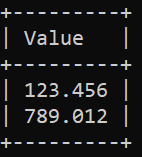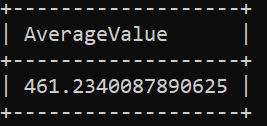What Represents a Double in SQL Server?
Last Updated :
20 Feb, 2024
In SQL Server, a DOUBLE data type represents a floating–point number that can store very large or very small values with high precision. It is commonly used for scientific calculations, financial applications, and any scenario where precise numeric values are crucial.
In this article, we will explore the characteristics and usage of the DOUBLE data type along with their examples and so on in SQL Servers.
What Represents a DOUBLE in SQL Server?
Doubles are represented by the float data type and efficiently handle numbers with decimals like 3.5 or 8.75. They provide flexibility by storing a large number of values including whole numbers and fractions.
This feature makes SQL Server well-suited for managing a variety of numeric data and ensuring it can adapt to different mathematical scenarios and calculations.
Usage of Doubles in SQL Server
Some of the double uses are:
- Storage: Each double value occupies 8 bytes (64 bits), providing ample space for complex calculations.
- Range: Doubles cover a vast spectrum, ranging from approximately -4.94e-324 to 1.79e+308 and allowing for extensive numerical possibilities.
double uses.
- Precision: With around 15-17 significant digits, doubles ensure good accuracy in most common scenarios.
Selecting the Correct Option
When deciding between float and other numeric data types like decimal, consider the following:
- Maximum Precision and Range: If these are critical, opt for float.
- Exact Decimal Representation with Space Constraints: Choose decimal.
- General Numerical Calculations: In most cases, float will be sufficient.
Examples of Using DOUBLE
1. Creating a Table with a Float Column.
Query:
CREATE TABLE Measurement (
Value float
);
2. Inserting Data into the Table
Query:
INSERT INTO Measurement (Value) VALUES (123.456);
INSERT INTO Measurement (Value) VALUES (789.012);
3. Querying and Retrieving Data
Query:
SELECT * FROM Measurement;
Output:

Float Table
Explanation: We have successfully insert the values.
4. Updating Data with Float Values.
Query:
UPDATE Measurement SET Value = Value + 10 WHERE Value < 500;
5. Mathematical Calculation with Aggregate Function.
Query:
SELECT AVG(Value) AS AverageValue FROM Measurement;
Output:

Average Value
Explanation: We have successfully find the average of the values.
6. Filtering and Counting Float Values.
Query:
SELECT COUNT(*) AS NumValuesAbove100 FROM Measurement WHERE Value > 100;
Output:

Counting Float Values
Explanation:
- A table named Measurement is created with a float column.
- Two rows are inserted with float values.
- The SELECT query retrieves and displays the inserted data.
Conclusion
When picking a data type for doubles in SQL Server it is important to have the strengths and constraints of float especially when compared to alternatives like decimal. By evaluating specific needs you can confidently choose a data type which enhances your database accuracy and efficiency. But Remember the decision between float and decimal depend on various factors like space, precision and range whichfast your applications numerical data requirements.
Share your thoughts in the comments
Please Login to comment...